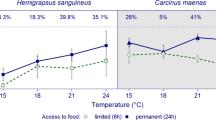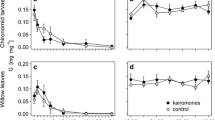Summary
Oxystele variegata (Anton.) exhibits a vertical size gradient contrary to the model proposed by Vermeij (1972) for low/mid intertidal species, as shell size increases in an upshore direction. Settlement occurs in the lowest zones and juveniles are restricted to the lower shore by conditions of desiccation higher up the beach. Juveniles suffer rapid water loss due to a relatively large opercular surface area and circumference and have a much lower resistance to water loss than adults. This leads to high mortality under conditions of low humidities, and juveniles caged at the top of the balanoid zone, where adults normally occur, die within a few days. As animals increase in size their resistance to desiccation rises allowing them to migrate upshore. This is a response to high rates of predation by the whelk Burnupena delalandii in the lower balanoid zone. Predation is so intense as to override the advantages of higher food availability which lead to a greater body weight for adults protected by cages on the lower shore.
Similar content being viewed by others
References
Bakker K (1959) Feeding habits and zonation in some intertidal snails. Arch neerl Zool13:230–257
Behrens S (1972) The role of wave impact and desication on the distribution of Littorina sitkana Phillipi, 1845. Veliger 15:129–132
Bertness MD (1977) Behavioural and ecological aspects of shore-level size gradients in Thais lamellosa and Thais emarginata. Ecology 58:86–97
Branch GM (1975) Ecology of Patella spp from the Cape Peninsula, South Africa. 4 Desiccation. Mar Biol 32:179–188
Broekhuysen GJ (1941) A preliminary investigation of the importance of desiccation, temperature and slinity as factors controlling the vertical distribution of certain intertidal marine gastropods in False Bay, South Africa. Trans roy Soc S Afr 28:255–292
Brown AC (1960) Desiccation as a factor influencing the vertical distribution of some South African Gastropada from intertidal rocky shores. Port Acta Biol (B) 7:11–23
Chow V (1975) The importance of size in the intertidal distribution of Littorina scutulata (Gastropoda: Prosobranchia). Veliger 13:69–78
Connell JH (1972) Community interactions on marine rocky intertidal shores. Ann Rev Ecol Syst 3:169–192
Coombs VA (1973) Desiccation and age as factors in the vertical distribution of the dog-welk Nucella lapillus.J Zool 171:57–66
Davies PS (1969) Physiological ecology of Patella III. Desiccation effects. J mar biol Ass UK 49:291–304
Desai BN (1966) The biology of Monodonta lineata (Da Costa). Proc Malacol Soc Lond 37:1–17
Emson RH, Faller-Fritsch RJ (1976) An experimental investigation into the effect of crevice availability on abundance and size structure in a population of Littorina rudis (Maton), Gastropoda: Prosobranchia. J exp mar Biol Ecol23:285–297
Lambert TC, Farley J (1968) The effect of parasitism by the trematode Cryptocotyle lingua (Creplin) on zonation and winter migration of the common periwinkle Littorina littorea(L.). Can J Zool 46:1139–1147
Markowitz DV (1980) Predator influence on shore-level size gradients in Tegula funebralis (A. Adams). J exp mar Biol Ecol 45:1–13
McQuaid CD (1980) Spatial and temporal variations in rocky intertidal communities. Ph D thesis, University of Cape Town pp 331
Micallef H (1970) The zonation of certain trochids under an artificial tidal regime. Neth J Sea Res 4:380–393
Moyse J,Nelson Smith A (1963) Zonation of animals and plants on rocky shores around Dale, Pembrokeshire. Fld stud 1:1–31
Paine RT (1969) The Pisaster-Tegula interaction: prey patchiness, predator food preferences and intertidal community structure. Ecology 50:950–961
Phillips DW (1976) The effect of a species-specific avoidance response to predatory starfish on the intertidal distribution of two Gastropods. Oecologia (Berl) 23:83–94
Raffaelli DG (1978) Factors affecting the population structure of Littorina neglecta Bean. J Molluscan Stud 44:223–230
Raffaelli DG, Hughes RN (1978) The effects of crevice size and availability on populations of Littorina rudis and Littorina neritoides. J anim Ecol47:71–83
Reimer AA (1976) Succession of invertebrates in vacant tests of Tetraclita stalactifera panamensis. Mar Biol 35:239–251
Strickland JDH, Parsons TR (1968) A practical handbook of sea-water analysis. Bull Fish Res Bd Can 167:1–311
Underwood AJ (1973) Studies on zonation of intertidal prosobranch molluscs in the Plymouth region. J anim Ecol 42:353–372
Underwood AJ (1979) The ecology of intertidal gastropods. Adv Mar Biol 16:111–210
Vermeij GJ (1972) Intraspecific shore-level size gradients in intertidal molluscs. Ecology 53:693–700
Walsby JR (1972) Population variations in the grazing turbinid Lunella smargda (Mollusca: Gastropoda). N Z J Mar Freshw Res 11:211–238
West RD (ed) (1975) Handbook of Chemistry and Physics.CRC Press, Cleveland
Author information
Authors and Affiliations
Rights and permissions
About this article
Cite this article
McQuaid, C.D. The influence of desiccation and predation on vertical size gradients in populations of the gastropod Oxystele variegata (Anton) on an exposed rocky shore. Oecologia 53, 123–127 (1982). https://doi.org/10.1007/BF00377146
Received:
Issue Date:
DOI: https://doi.org/10.1007/BF00377146




